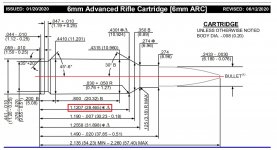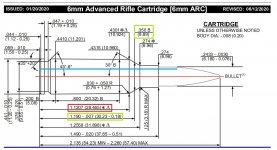I am about to start load development of my 6mm ARC. I have over 100 something pieces of brass that I shot from factory ammo.
My question, or rather the discussion I would like to have is about resizing brass.
An unfired round straight from Hornady measured 29.2mm at the shoulder. After firing my brass measures 29.4mm. In inches that's .00787 inches difference in fired vs unfired.
Keep in mind that I might not have used the exact right comparator for the measurement so I might have been slightly up on the shoulder a little bit, but the measurement from both fired and unfired were done using the same tool. I did it to know what the difference is, or in other words how much my cases grow in my chamber.
In the image below I am focusing on (roughly) the dimension highlighted in red.
Now, with that said I have never really been a guy that chases lands or any of that but I do find the 'jam' point as Erik Cortina called it in his video(s). On that note there are two ways to get to that jam point. You can either have brass that is shorter or longer (or possibly inconsistent), or you can simply seat the bullet longer or shorter to compensate.
In your opinion, given the above mentioned numbers, what would the possible 'ideal' amount to size my brass back to from it's fired state?
My question, or rather the discussion I would like to have is about resizing brass.
An unfired round straight from Hornady measured 29.2mm at the shoulder. After firing my brass measures 29.4mm. In inches that's .00787 inches difference in fired vs unfired.
Keep in mind that I might not have used the exact right comparator for the measurement so I might have been slightly up on the shoulder a little bit, but the measurement from both fired and unfired were done using the same tool. I did it to know what the difference is, or in other words how much my cases grow in my chamber.
In the image below I am focusing on (roughly) the dimension highlighted in red.
Now, with that said I have never really been a guy that chases lands or any of that but I do find the 'jam' point as Erik Cortina called it in his video(s). On that note there are two ways to get to that jam point. You can either have brass that is shorter or longer (or possibly inconsistent), or you can simply seat the bullet longer or shorter to compensate.
In your opinion, given the above mentioned numbers, what would the possible 'ideal' amount to size my brass back to from it's fired state?
Attachments
Last edited:



